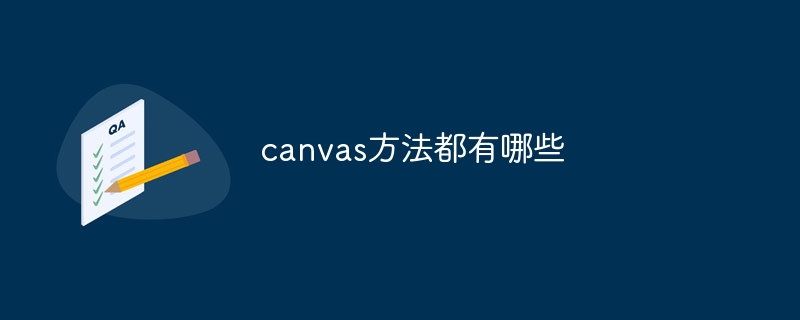
Common canvas methods include getContext(), fillRect(), strokeRect(), clearRect(), beginPath(), moveTo(), lineTo(), arc(), fill(), stroke() , save(), restore() methods, etc. Detailed introduction: 1. getContext() method to obtain the Canvas drawing context; 2. fillRect() method, etc.

The operating environment of this tutorial: Windows 10 system, Dell G3 computer.
Canvas is an element in HTML5 that provides a way to draw graphics using JavaScript. Through Canvas, developers can draw graphics, create animations, process images, etc. on web pages. Canvas provides a series of methods for drawing and manipulating graphics.
The following are some commonly used Canvas methods:
1. getContext(): Get the Canvas drawing context. Using the getContext() method, you can obtain a drawing context object through which drawing and operations can be performed.
Sample code:
var canvas = document.getElementById("myCanvas");
var context = canvas.getContext("2d");2. fillRect(): Draw a filled rectangle. The fillRect() method is used to draw a filled rectangle and can set the position, size and color of the rectangle.
Sample code:
context.fillRect(x, y, width, height);
3. strokeRect(): Draw a border rectangle. The strokeRect() method is used to draw a border rectangle and can set the position, size and color of the rectangle.
Sample code:
context.strokeRect(x, y, width, height);
4. clearRect(): Clear the rectangular area. The clearRect() method is used to clear the contents of the specified rectangular area and can be used to erase graphics on the canvas.
Sample code:
context.clearRect(x, y, width, height);
5. beginPath(): Start path. The beginPath() method is used to start a path, which can be used to draw lines, curves, and shapes.
Sample code:
context.beginPath();
6. moveTo(): Move the starting point of the path. The moveTo() method is used to move the starting point of the path to the specified coordinate point.
Sample code:
context.moveTo(x, y);
7. lineTo(): Draw a straight line. The lineTo() method is used to draw a straight line from the starting point of the current path to the specified coordinate point.
Sample code:
context.lineTo(x, y);
8. arc(): Draw an arc. The arc() method is used to draw an arc. You can set the center point, radius, starting angle, and ending angle of the arc.
Sample code:
context.arc(x, y, radius, startAngle, endAngle);
9. fill(): fill the path. The fill() method is used to fill the content of the current path and can set the fill color and style.
Sample code:
context.fill();
10. stroke(): Draw a path border. The stroke() method is used to draw the border of the current path and can set the color and style of the border.
Sample code:
context.stroke();
11. save(): Save the canvas state. The save() method is used to save the state of the current canvas, including the current transformation, style, clipping area, etc.
Sample code:
context.save();
12. restore(): Restore the canvas state. The restore() method is used to restore the previously saved canvas state and apply the previously saved state to the current canvas.
Sample code:
context.restore();
The above are some commonly used Canvas methods, through which various drawing and graphics operations can be achieved. Developers can choose the appropriate method to draw and operate Canvas according to their own needs.
The above is the detailed content of What are the canvas methods?. For more information, please follow other related articles on the PHP Chinese website!
 What are the production methods of html5 animation production?
What are the production methods of html5 animation production?
 How to close the window opened by window.open
How to close the window opened by window.open
 How high will Ethereum go?
How high will Ethereum go?
 caj file opening method
caj file opening method
 What are the commonly used functions of informix?
What are the commonly used functions of informix?
 The Metaverse recognizes the top ten potential coins
The Metaverse recognizes the top ten potential coins
 How to skip online activation in win11
How to skip online activation in win11
 What are the big data storage solutions?
What are the big data storage solutions?
 How to check computer IP
How to check computer IP




